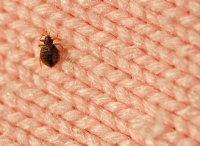Healthy Homes - Bed Bugs
What do bed bugs look like?
Bed bugs are small, reddish-brown insects that are about the size of an apple seed (4-5 mm long). They have oval, flat bodies when unfed and become swollen and more elongated after feeding on blood. Bed bugs do not have wings but can move quickly across floors, walls, and furniture. Their eggs are tiny, white, and difficult to spot with the naked eye.
How can I tell if bed bugs are in my bed?
Bed bugs often bite people at night during sleep. One of the easiest ways to identify a bed bug infestation is by the tell-tale bite marks on the face, neck, arms, hands or any other body parts while sleeping. It is important to look for other bed bug clues where you sleep.
Signs of a bed bug infestation include:
• Small, rust-colored stains on sheets or mattresses (bed bug excrement)
• Tiny white eggs or eggshells in mattress seams or cracks
• Shed skins from bed bugs as they grow
• Live bed bugs hiding in mattress seams, headboards, bed frames, and other tight spaces
• An unexplained musty odor in the bedroom
How can I tell a bed bug bite from other bug bites?
Bed bug bites often appear as small, red, itchy welts, typically in a line or cluster. Unlike mosquito bites, which are more random, bed bug bites usually follow a pattern on exposed areas like the face, neck, arms, and legs. Some people do not react to bed bug bites, while others may experience severe itching or allergic reactions.
Bed bug bite marks are similar to that of a mosquito or a flea -- a slightly swollen and red area that may itch and be irritating. It is hard to tell if you’ve been bitten by a bed bug unless you find bed bugs or signs of infestation. When bed bugs bite, they inject an anesthetic and an anticoagulant that prevents a person from realizing they are being bitten. Most people do not realize they have been bitten until bite marks appear from one to several days later.
What health risks do bed bug bites pose?
While bed bugs are not known to transmit diseases, their bites can cause:
• Itching and skin irritation
• Allergic reactions in sensitive individuals
• Secondary infections from excessive scratching
• Sleep disturbances and anxiety due to persistent infestations
To cope with bed bug bites try to avoid scratching and apply antiseptic cream or lotion. Maybe take an antihistamine. People who excessively scratch itchy bug bites can increase the chance of a secondary skin infection.
Bed bug bites affect everyone differently. Some people may have no reaction and will not develop bite marks or visible signs of being bitten. Other people may be allergic to the bed bugs and can react with enlarged bite marks and painful swelling at the bite site. Bed bugs bites are not considered to be dangerous, though an allergic reaction may need medical attention.
Who has good websites about bed bugs?
In addition to the information on this page, we can recommend the information on the Environmental Protection Agency’s bed bug webpage and the University of Tennessee’s bed bugs webpage. These websites are updated regularly and have high-quality, peer-reviewed information and photographs of bed bugs.

Government partners
Tennessee Department of Health
Pesticides
www.tn.gov/health/cedep/environmental/environmental-health-topics/eht/pesticides.html
University of Tennessee
Bed Bugs in Tennessee
bedbugs.tennessee.edu
Environmental Protection Agency (EPA)
Bed Bugs: Get Them Out and Keep Them Out
www.epa.gov/bedbugs
Centers for Disease Control and Prevention (CDC)
Bed Bug FAQs
www.cdc.gov/bed-bugs/about/index.html
Other resources
Stop Pests in Housing
Integrated Pest Management (IPM) resources
www.stoppests.org
Helpful documents
University of Tennessee
Affordable Bed Bug Management?
Bed Bugs Management and Prevention
Centers for Disease Control and Prevention (CDC)
Healthy Advisory: Health Concerns about Misuse of Pesticides for Bed Bug Control
